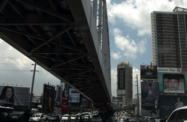Government authorities are looking to ease traffic congestion and boost the Philippines’ ageing infrastructure by increasing government funding and streamlining the approval process for transport projects.
Infrastructure was one of the major winners in the Philippines’ draft 2017 budget, released in mid-August, with a total allocation of P860.7bn ($17.8bn), a 13.8% increase on funding from this year’s spending programme.
If the proposed budget is approved, total infrastructure allocations, including transport, will account for 5.4% of overall budgetary outlays next year.
Request for emergency powers
In addition, in late September the Senate convened its third and final meeting on granting President Rodrigo Duterte emergency powers to speed delivery of major transport infrastructure. The proposed Traffic and Congestion Crisis Act of 2016, requested by the Department of Transport (DoT), is meant to ease congestion, particularly in Manila.
This meeting followed the Senate’s request in late August for the DoT and the Metropolitan Manila Development Authority to submit a detailed list of projects that would by covered under the expanded powers, and for a set of safeguards to be drafted to avoid irregularities in the tendering process.
The first two meetings – both of which took place in August – were held to ensure transparency throughout the process and to consult with the public regarding the country’s current transport problems.
DoT’s calls for enhanced authority aim to hasten the lengthy process of acquiring right-of-way, while also blocking lower courts from issuing rulings that could potentially delay or halt projects, Arthur Tugade, secretary of transportation, told local media in late August.
Emergency powers could also pave the way for the DoT to create a single traffic authority with uniform rules, which would standardise road operation and management guidelines nationwide, Tugade said. Currently, both the local and national administrations follow different standards, which at times hinders infrastructure coordination and integration.
The Senate is expected to vote on the bill in December, at the same time it votes on the 2017 draft budget.
If granted, the emergency powers regime could fast-track some P1.2trn ($24bn) worth of road, rail, sea and air transport projects, according to media reports.
However, while the benefits of the bill could be felt as soon as 2018 or 2019, it could take much longer – a decade at least – to address the country’s infrastructure gap, according to Benjamin E Diokno, secretary of budget and management.
Currently, the Philippines ranks 90 out of 140 countries in terms of adequacy of infrastructure, according to the World Economic Forum’s “2016 Global Competitiveness Report”.
Initial steps already taken
While awaiting approval on the DoT request, government authorities have already taken steps to streamline the approval process for broader infrastructure projects.
In August Ernesto Pernia, director-general of the National Economic and Development Authority (NEDA), said that projects with a budget under P5bn ($104.5m) will no longer need to be ratified by the NEDA.
Previously, the ceiling on infrastructure projects that did not require agency approval was P1bn ($21m). The raised spending ceiling is expected to support smaller-scale developments, particularly those in urban centres outside of Metro Manila.
"What we intend to do is to focus now on the sub-national and regional economies, including rural areas and agriculture in order to disperse development away from mega urban industrial regions," Pernia said.
Meanwhile, in September the NEDA board approved nine infrastructure projects valued at P171bn ($3.5bn) in its first meeting under the new administration. Six of the approved projects are outside of Manila, including an agricultural competiveness campaign across 44 provinces.
Among the projects approved for Manila was the DoT’s P37.8bn ($782m) Metro Manila Bus Rapid Transmit (BRT) system, which should help ease traffic congestion in the capital. The system will follow a 48.6-km route along the Epifanio de los Santos Avenue from Monumento, Quezon City to Roxas Boulevard, Manila. The BRT system is slated to have up to 63 stations, as well as link to the Ninoy Aquino International Airport.
The project is expected to start next year and be operational in 2020.
Oxford Business Group is now on Instagram. Follow us here for news and stunning imagery from the more than 30 markets we cover.

